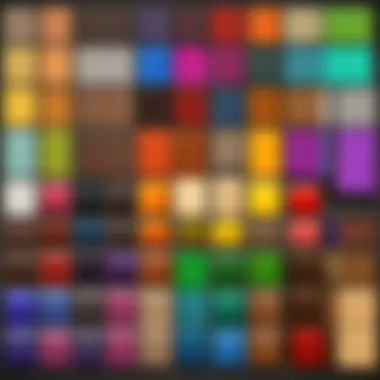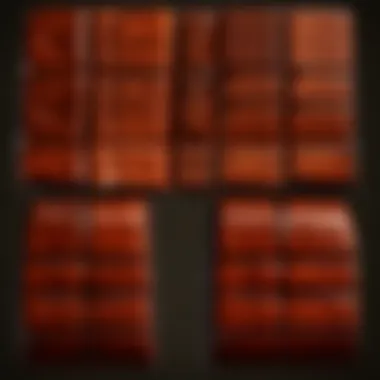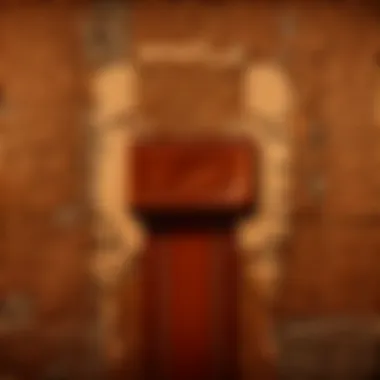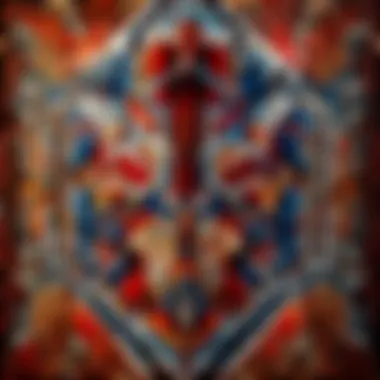Mastering the Art of Leather Dyeing: A Comprehensive Step-by-Step Guide


Dyeing leather is a meticulous process that requires attention to detail and precision. This guide will take you through the steps of transforming leather items with dye, whether for fashion, customization, or restoration purposes. Mastering the art of dyeing leather opens up a plethora of creative possibilities and allows you to breathe new life into your leather possessions.
Choosing the Right Dye
Before embarking on your leather dyeing journey, it is crucial to select the appropriate dye for the desired outcome. Various types of dyes are available, including oil-based, water-based, alcohol-based, or even natural dyes derived from plant sources. Consider the colorfastness, durability, and penetration levels of the dye to ensure a long-lasting and vibrant finish on your leather piece.
Preparation and Testing
Prepare your leather item for dyeing by cleaning it thoroughly with a leather cleaner to remove any dirt or residue. Test the chosen dye on a small, inconspicuous area of the leather to assess the color accuracy and absorption rate. This step is essential to avoid any surprises and ensure a consistent finish on the entire item.
Application Techniques
When applying the dye to your leather, consider the various techniques available, such as sponge applicators, brushes, or airbrushing for intricate designs. Ensure even coverage by working in thin, uniform layers and allowing each coat to dry before applying the next. Take your time and pay attention to detail to achieve a professional-looking result.
Finishing Touches
Once the leather has absorbed the dye and dried completely, it is essential to apply a leather finisher or sealer to protect the color and enhance the durability of the dyed surface. Choose a finisher that matches the desired sheen level, whether matte, satin, or glossy, and apply it evenly to seal in the color and provide a polished look.
Conclusion
Introduction to Leather Dyeing
Leather dyeing serves as a fundamental process in the realm of leatherwork, encapsulating the essence of transforming mundane leather goods into vibrant, personalized masterpieces. Understanding the intricacies of leather dyeing is akin to deciphering an artist's palette, enabling individuals to breathe new life into their leather items. By delving into the depths of this craft, enthusiasts can explore a spectrum of hues and effects, unlocking boundless creative expressions. The significance of mastering leather dyeing resonates across various sectors, whether it pertains to fashion embellishments, bespoke customization, or meticulous restoration endeavors. This section elucidates the core principles that underpin the art of leather dyeing, offering readers a comprehensive insight into its multifaceted applications.
Understanding the Basics
What is leather dyeing?
Embarking on a journey of understanding what leather dyeing entails unveils a realm where colors meet craftsmanship in seamless harmony. At its essence, leather dyeing involves the process of imbuing leather surfaces with rich, pigmented solutions to enhance their aesthetic appeal. This transformative technique goes beyond mere coloring; it encapsulates an amalgamation of science and artistry, ensuring that each dyed piece narrates a unique story. The allure of leather dyeing lies in its versatility and permanence, as dyes penetrate the leather fibers, creating enduring shades that withstand the test of time. The inherent beauty of leather dyeing resides in its ability to revive worn-out leather articles, infusing them with a new lease of life.
Types of leather suitable for dyeing


Dedicating attention to the types of leather that harmonize best with dyeing processes is pivotal in achieving successful outcomes. Different varieties, such as full-grain, top-grain, and bonded leather, react diversely to dyes due to variations in their composition and porosity. While full-grain leather, renowned for its natural texture and durability, readily absorbs dyes, bonded leather may present challenges due to its synthetic composition. Understanding the characteristics of each leather type empowers artisans to choose suitable dyeing techniques, ensuring optimal color vibrancy and adherence. Selecting the right leather for dyeing endeavors is a strategic decision that influences the final aesthetic and longevity of the dyed piece.
Benefits of dyeing leather
The benefits bestowed by the art of dyeing leather extend far beyond surface-level aesthetics, delving into realms of creativity and preservation. Dyeing leather not only allows individuals to personalize their possessions according to their preferences but also enables them to repurpose old items, reducing waste and fostering sustainability. By investing time and effort into mastering leather dyeing, artisans can rejuvenate faded belongings, infusing them with fresh colors and extending their usability. Furthermore, the therapeutic nature of leather dyeing serves as a meditative outlet for enthusiasts, fostering a sense of accomplishment as they witness raw leather metamorphose into vibrant works of art. The enchanting journey of dyeing leather transcends mere color application, encapsulating stories, memories, and creative expressions within each dyed piece.
Dyeing Techniques
Dyeing Techniques play a pivotal role in the process of transforming leather, making it a crucial aspect to discuss in this comprehensive guide on leather dyeing. By exploring different dyeing techniques, individuals can achieve various effects, whether solid colors or intricate patterns, on their leather items. Understanding the nuances of application methods is essential to mastering the art of leather dyeing.
Application Methods
Dip Dyeing
Dip dyeing involves immersing the leather item into a dye solution to achieve a uniform color saturation. This method is popular for creating gradient effects or completely changing the color of the leather. Its efficiency lies in the ability to dye large areas quickly and uniformly. However, dip dyeing requires careful handling to avoid over saturation and color inconsistencies that can arise from uneven dipping.
Spray Dyeing
Spray dyeing utilizes a pressurized sprayer to apply dye onto the leather surface evenly. This method is ideal for achieving a more refined, consistent finish as compared to other application techniques. The advantage of spray dyeing lies in its ability to cover intricate details and contours of the leather item effectively. However, overspray and airborne particles can lead to wastage of dye and potentially create a messy working environment.
Brush Dyeing
Brush dyeing involves using a brush or sponge to apply dye onto the leather manually. This method offers more control over color placement and intensity, especially when working on intricate designs or small areas. Brush dyeing allows for blending different colors seamlessly and achieving a nuanced, layered effect. However, it requires patience and skill to ensure even coverage without brush strokes or blotches.
Achieving Different Effects
Solid Color Dyeing
Solid color dyeing focuses on achieving a uniform color across the leather surface, enhancing its overall appearance and concealing imperfections. This method is straightforward and suitable for beginners looking to create a consistent look on their leather items. The simplicity of solid color dyeing makes it a go-to choice for quick transformations, offering a classic and timeless result. However, maintaining even coverage without streaks poses a challenge that requires attention to detail.
Antiquing and Distressing
Antiquing and distressing techniques add character and depth to leather items by simulating age and wear. By selectively removing dye or applying additional layers in specific areas, a weathered or vintage look can be achieved. This method is popular for creating unique, personalized pieces with a distinctive aesthetic. However, achieving the desired level of antiquing and distressing requires practice and experimentation to strike the perfect balance between subtlety and impact.


Two-Tone Dyeing
Two-tone dyeing involves using two different colored dyes to create contrast or visual interest on the leather surface. By combining complementary or contrasting colors, intricate patterns or striking designs can be produced. This technique allows for artistic expression and customization, offering endless possibilities for unique leather creations. However, precision and skill are essential to ensure smooth color transitions and avoid color bleeding or mixing.
Troubleshooting and Fixes
Uneven Dye Coverage
Uneven dye coverage can occur due to inconsistencies in application, resulting in patchy or splotchy areas on the leather. To address this issue, reapplying dye in thin, even layers can help achieve a more uniform color distribution. Additionally, using a brush or sponge to blend out uneven spots can enhance overall coverage and finish. Preventing uneven dye coverage requires patience and attention to detail during the dyeing process.
Color Fading Issues
Color fading issues may arise over time due to exposure to sunlight, moisture, or friction. To maintain the vibrancy of dyed leather, applying a protective finish or sealant can help shield the dye from external factors. Regular conditioning and avoiding prolonged sun exposure can also prolong the longevity of the dye. Preventing color fading requires proper care and maintenance of dyed leather items to preserve their appearance and color intensity.
Sealing the Dye
Sealing the dye is essential to lock in the color and protect it from wear and tear. By applying a sealant or topcoat specifically designed for leather dyes, the color remains intact and resistant to fading or rubbing off. Properly sealing the dye enhances the durability and longevity of the color, ensuring that the dyed leather item maintains its visual appeal over time. Choosing the right sealant and applying it correctly are critical steps in preserving the integrity of the dye on leather items.
Advanced Tips and Tricks
In the realm of leather dyeing, mastering advanced tips and tricks can elevate your craft to the next level. These insights go beyond basic techniques, offering intricate methods to customize, preserve, and enhance dyed leather projects. By delving into this section, readers will uncover invaluable strategies that can transform the way they approach and execute leather dyeing processes. Understanding the nuances of advanced tips and tricks will not only fine-tune your skills but also open doors to creative experimentation and innovation.
Customizing Leather Projects
Customizing leather projects is a pivotal aspect of leather dyeing, allowing individuals to add a personal touch and unique flair to their creations. Within this domain, there are several key elements to consider, starting with 'Adding patterns and designs.' This technique enables artisans to imprint intricate motifs or imagery onto leather surfaces, creating visually compelling outcomes that speak to individual style and creativity. Despite its meticulous nature, adding patterns and designs brings unmatched character and sophistication to leather goods, making it a preferred choice for those looking to imbue their projects with a distinctive aesthetic appeal.
On the other hand, 'Mixing dyes for unique shades' offers a versatile approach to crafting customized color palettes. By blending different dyes, artists can generate a spectrum of hues and tones that are tailored to their preferences and project requirements. This process not only allows for greater color customization but also facilitates the creation of striking and unconventional shades that set projects apart. While mixing dyes requires precision and experimentation, the endless possibilities it presents make it a favorable technique for individuals seeking to push the boundaries of traditional leather dyeing.
Lastly, 'Creating artistic effects' introduces a realm of creativity and innovation to leather projects. This technique involves using various tools and methods to achieve distinctive textures, finishes, or visual elements in dyed leather items. From marbling and ombre effects to metallic accents and abstract designs, the artistic effects category empowers artisans to sculpt truly unique and captivating pieces. While it demands a keen eye for detail and artistic sensibility, incorporating these effects can elevate ordinary projects into extraordinary works of art, demonstrating the transformative power of artistic experimentation.
Choosing the Right Dye for the Job
Selecting the appropriate dye for a leather project is a critical decision that significantly impacts the final outcome. Within this realm, understanding the contrasts between 'Acrylic vs. alcohol-based dyes' is essential. Acrylic dyes offer quick-drying properties and vibrant color saturation, making them ideal for projects that require rapid turnaround and vivid hues. In contrast, alcohol-based dyes provide greater color depth and nuance, offering artists more control over the layering and blending of colors for nuanced effects.


On the other hand, 'Permanent vs. semi-permanent dyes' delineate the longevity and durability of dyed leather items. Permanent dyes penetrate the leather deeply, ensuring color longevity and resistance to fading and wear. Alternatively, semi-permanent dyes offer a more temporary solution, allowing for color updates and modifications over time. The choice between these two types of dyes depends on the intended use and longevity requirements of the leather project.
Lastly, 'Considerations for different leather types' emphasize the significance of matching dyes to specific leather varieties. Different types of leather, such as full-grain, top-grain, or suede, have unique characteristics and absorbencies that necessitate tailored dyeing approaches. By considering the inherent qualities of each leather type, artists can ensure optimal dye penetration, color vibrancy, and long-term durability in their projects.
Preserving and Maintaining Dyed Leather
Once leather items are dyed, preserving and maintaining their aesthetic and structural integrity is crucial for longevity and visual appeal. 'Proper storage practices' play a pivotal role in preventing color fading, moisture damage, and physical wear on dyed leather goods. Utilizing appropriate storage containers, protecting items from sunlight exposure, and maintaining consistent humidity levels can significantly extend the lifespan and vibrancy of dyed leather.
Additionally, 'Cleaning and conditioning' leather products regularly is essential to remove dirt, oils, and residues that can dull the dye finish and lead to deterioration over time. Using non-abrasive cleaning methods and high-quality leather conditioners not only refresh the appearance of dyed leather but also nourish and protect the material for enhanced durability and suppleness.
Lastly, 'Refreshing faded dyes' offers a solution for restoring the vibrancy and depth of colors in dyed leather items. Through targeted dye touch-ups or color restoration techniques, artisans can revitalize the appearance of worn or faded areas, breathing new life into cherished leather pieces. Incremental care and maintenance, including periodic dye refreshenings, ensure that dyed leather retains its beauty and allure for years to come.
Conclusion
When delving into the intricate world of leather dyeing, the conclusion serves as a pivotal moment of reflection and consolidation. It encapsulates the essence of meticulous preparation, unbridled creativity, and the relentless pursuit of excellence. The importance of this final section lies in summarizing the key takeaways and emphasizing the transformative power of mastering the art of dyeing leather. Readers are reminded of the endless possibilities that await, whether it is in the realm of fashion, customization, or restoration.
Summary of Key Points
Importance of Proper Leather Preparation
The cornerstone of successful leather dyeing, proper leather preparation sets the foundation for exceptional results. By meticulously cleaning, degreasing, and priming the leather surface, artisans pave the way for flawless dye absorption and lasting color vibrancy. The meticulous nature of this process ensures that every intricate detail of the leather item is accentuated, leading to a professional and refined finish.
Experimentation Leads to Unique Results
Embracing the spirit of experimentation unlocks a world of creative exploration and innovation. Each dyeing session becomes a canvas for artistic expression, allowing for the fusion of colors, textures, and techniques to yield one-of-a-kind results. Through trial and error, artisans discover new techniques, juxtapositions, and effects, adding depth and personality to their leather creations.
Continuous Learning and Improvement
The journey of leather dyeing is a perpetual evolution towards mastery. Embracing a mindset of continuous learning empowers artisans to refine their techniques, expand their repertoire, and push the boundaries of their creativity. Every project becomes an opportunity for growth, with each challenge fueling a drive for improvement and excellence.
Final Thoughts
Empowering Creativity Through Leather Dyeing
At the heart of leather dyeing lies a profound ability to unleash boundless creativity. By wielding dyes as brushes and leather as canvas, artisans embark on a transformative journey of self-expression and ingenuity. The act of dyeing transcends mere color application, becoming a medium through which ideas, emotions, and stories are vividly brought to life.
Endless Possibilities in Leather Customization
The allure of leather customization lies in its infinite potential for personalization and uniqueness. From subtle tonal shifts to bold artistic motifs, every design choice reflects the individuality and vision of the artisan. Whether seeking to revamp old favorites or create new masterpieces, the landscape of leather customization beckons with endless avenues for exploration and self-discovery.



